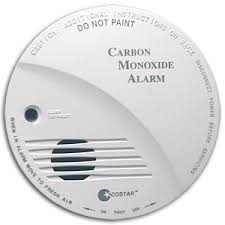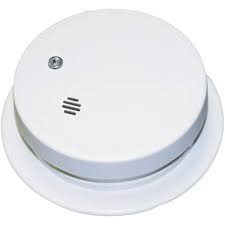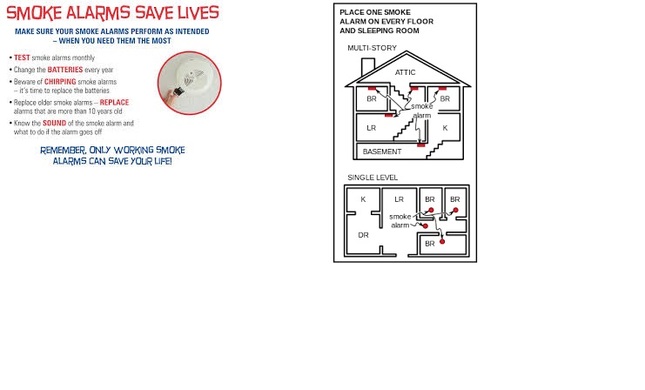 These pictures require no introduction, they are of course, your communal garden variety smoke detector and CO detector. If you are lucky, and live in a properly equipped home, you should have several of these scattered around your house.. Smoke detectors and their distant cousins ;carbon monoxide or CO detectors, have changed very little since their inception and introduction.or at least from a design standpoint. On a good day, they should sit quietly and do absolutely nothing. On a bad day however, they should do as designed and emit an unholy racket, which Should by all accounts awaken the deceased from their eternal slumber. That is to say, when triggered by enough volume of smoke and or CO in the living space, they are supposed to awaken and or alert the homes occupants to a present danger (smoke,fire, and or CO) this is achieved by emitting an ear piercing alarm, which on average is in the 85 decibel range designed to wake up even the most comatose of sleepers (you know who you are).. Hopefully yours have ever only been triggered by a round of burnt toast. Smoke detectors when working properly and correctly installed, have saved a lot of lives over the years, as have their cousins the humble CO detector. This is why it's so very important to make sure and test your detectors on a monthly basis. It only takes a second to do, but failure to do so can be very very expensive indeed, Especially when the cost is a human life. If you have battery versions of these devices please remember to replace the batteries annually without fail. Hard wired and battery operated smoke and CO detectors should be replaced every 10 years or so.. Both Smoke detectors and CO2 detectors are available as plug in models. which in my personal opinion is to avoid them like the plague. The reason being, is in the event of a power outage you will be left unprotected. Correct Smoke detector placement Here is a handy illustration (see below)-which depicts suggested placement of detectors throughout the home. But just in case you prefer text. let me spell it out. According to the NFPA (national fire protection agency) smoke detectors should be hard wired where possible and be located in the following locations.
Co detector placement
Given that CO is slightly lighter than air, and as a result has a tendency to rise,it is considered best practice. to mount your detection equipment at approximately 6ft (eye level on your walls) in a home with standard 8ft ceilings.. Apart from that , placement is relatively similar to that of your smoke detection equipment. As a rule of thumb, place a unit within 10ft of every bedroom door on a homes sleeping levels. and within 10ft of an attached garage on the main level Each level of the home should have its own CO detector. To avoid false readings, detectors should be placed at least 15ft away from a device which burns fossil fuels such as,. furnaces stoves, gas dryers, and fireplaces. Other mounting considerations would suggest you keep the unit away from direct sunlight, strong breezes and drafts or behind draperies/curtains which can block the sensor. Types of Smoke detectors Ionizing type- Consists of battery charged metal plates and a trace amount of the radioactive element, Americium 241. When smoke enters the ionization chamber it disrupts the flow of electrons. this disruption causes the alarm to be triggered. Photoelectric or photo voltaic type.- This is the simpler of the two devices and works when smoke enters the detector it block or disrupts the light receptors inside the unit , and thus causing the alarm to sound. Combination Photoelectric\Ionizing type - the best of both worlds here- and the best way of protecting your home and loved ones in my opinion. You get, ionization detection for sudden, low smoke flame-ups, and photoelectric sensors for smoky, slow-burning fires. Types of CO Detectors Biomimetic sensor: A gel changes color when it absorbs carbon monoxide, This color change triggers the alarm. . Metal oxide semiconductor: When the silica chip's circuitry detects carbon monoxide, it lowers the electrical resistance, and thus triggers the alarm. Electrochemical sensor: Electrodes immersed in a chemical solution sense changes in electrical currents when they come into contact with carbon dioxide, and this change triggers the alarm.- much like the Ionizing type smoke detector. Both Smoke and CO detectors are readily available at most major hardware stores and big box mart stores. Neither variety is expensive, so there really is no valid excuse for not having either one or both installed. In fact, it is illegal to not have an operating unit in your home ,as per Illinois law. 430 Ill. Comp. Stat. § 135/ -- Carbon Monoxide Alarm Detector Act Requires that every dwelling unit shall be equipped with at least one approved carbon monoxide alarm in an operating condition within 15 feet of every room used for sleeping purposes. Every structure that contains more than one dwelling unit shall contain at least one approved carbon monoxide alarm in operating condition within 15 feet of every room used for sleeping purposes. Carbon monoxide poisoning is a serious public health concern. Over 10,000 are poisoned by carbon monoxide needing medical treatment each year; over 500 people in the U.S. die annually from carbon monoxide poisoning.. please don't become part of this statistic. As always we hope you have found this post both useful and or at the very least informative. If you are not comfortable doing it yourself Britannia Home services is able to replace and or test your smoke Alarms and CO2 detectors for you. Cheers Bruce
1 Comment
|
AuthorHi My Name is Bruce Kenny and I am the owner and founder of Britannia Home Services. I am married with 3 kids and reside in Naperville Illinois. Archives
April 2018
Categories |
|


 RSS Feed
RSS Feed